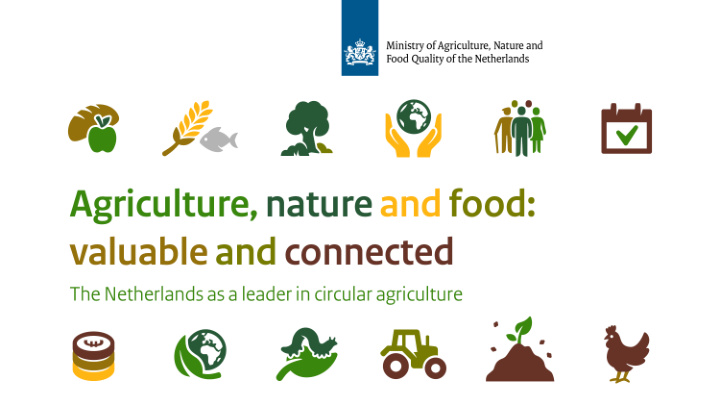



Agriculture in 2019 • Maximum yields from limited resources • Innovation • Triple helix approach
The challenges we face • Depletion of soil, freshwater supplies and raw materials • Decline in biodiversity • Climate change • Wastage of food and residues • Fair income for farmers and growers
Towards circular agriculture • Respecting the Earth’s limits: food production to the benefit of nature, environment and climate • From a linear system to a circular system • From reducing costs to reducing use of raw materials and environmental impact • Closing nutrient cycles at as low a level as possible (regional, national, international) and preventing waste • Cooperation in food production chain • Cutting costs
What is circular agriculture? • Arable farming, livestock farming and horticulture primarily use raw materials from each other’s supply chains and waste flows from food industry and food supply chains • A healthy soil is key: low input - use nutrients and the soil in such a way that the soil system can recover and regenerate • Optimisation/valorisation of residual biomass: feed, organic fertiliser • Food waste = feed • Animal manure first • Energy: as little as possible, renewable • New technology
What is circular agriculture? • Soil! • Precision farming, new plant breeding techniques • Strip cropping, pixel cropping, agroforestry • Integrated crop protection / pest management
What is circular agriculture? • No emissions into soil, water and air • As little water as possible • Strive to be climate-neutral • Renewable and residual energy • Closed systems close to consumers
What is circular agriculture? • Cattle fed primarily with grass, feed crops, crop residues or food industry residues (from own farm or immediate vicinity) • While taking account of food safety issues, work towards full use of all these residues for animal feed or as fertilizer for indoor horticulture • Replacing artifical fertilizers by (extracts from) animal manure
Conditions for a succesful transition 10
From vision to implementation • Substantial part of Ministry’s budget allocated to the transition, plus additional funds (pig industry restructuring, nature and water quality) • Continuous consultation of stakeholders on putting the vision into practice • Setting environmental, food safety and animal welfare goals with stakeholders • Adjust legislation where necessary • Strategic national plans under Common Agricultural Policy 2021-2027 • Research Agenda ’19-’23: circular agriculture, small robots, soil management, etc. • Annual Soil Summit, monitoring of soils • Precision Farming Agenda
From vision to implementation • Experimental zones run by farmers • Trialing agroforestry, strip cropping, catch crops, cover crops • Unfarmed land made available to develop 40 nature-friendly businesses • Reduction of artificial fertilizer use: support for trials, change EU rules • Efforts to adjust EU biotechnology legislation, e.g making way for gene editing • Agreement with industry on full re-use of food waste by 2020
From vision to implementation • Research into the setting of prices across the supply chain • Research into true costs and true cost accounting • Dispute settlement scheme for price setting • Legal ban on a number of unfair trading practices • Consumer and Markets Authority will enforce that primary producers receive a higher price from buyers who make demands that go beyond the regulatory baseline, e.g. on animal welfare • Incentivise longer tenancies • Succession fund for new entrants who want to invest in sustainability
Benchmarks for measures • do they help to close cycles, to reduce emissions and to reduce biomass wastage throughout the food system? • do they strengthen the socio-economic position of the farmer in the supply chain? • do they contribute to the climate task for agriculture and land use? • do they benefit ecosystems (water, soil, air), biodiversity and the natural value of the farming landscape? • has animal welfare been considered? • do they contribute to the recognition of the value of food and to strengthening the relationship between farmers and citizens? • do they strengthen the position of the Netherlands as a developer and exporter of integrated solutions for climate-smart and ecologically sustainable food systems? • Food safety!
From vision to implementation • International knowledge development and sharing: gather examples and ideas from abroad • Exporting of innovative production methods • The Netherlands leader in circular agriculture by 2030
Connect www.government.nl/visionanf with us! #NorthSeaNeighbours @NLinUK @AgriLondon @timheddema LON-LNV@minbuza.nl
Recommend
More recommend